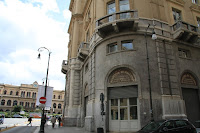Anagrafe Information
Here is some information about the anagrafe offices (link 1 and link 2). They are in Italian. Unfortunately, they don't tell you the most important thing which is that the office for old records is right across from the main train station, conveniently located. It’s a grayish, formidable looking building with brown signage above the windows saying “Muncipio di Palermo”. During off hours, you can’t really look in any windows because everything is shut up. Normal hours are something like 8:30 to 1:30 (check to confirm). When you enter through a gate on the side of the building (away from the ocean) there are several doors to choose from. One door is the place you pick up previously requested information or things that are already in the computer. It’s the “sportello”. The other door has a security guard inside and that’s where you should go if you need to do research. You want to ask the guard to take you to door #6. It’s just to the left of the elevator past the guard post. Below is a picture of the building with the main train station in the background.

Once inside the door, you meet someone there and you can state what you need. As usual, having all the information on one or more sheets of paper and easy to read will help. Also be prepared to take notes as it will help to record dates and volume/number from the index (more below).
You can get photocopies for just a few cents apiece or you can ask for an extract. The extract might take a day or so to process since the information has to be typed into the computer. Then you can just go to the sportello and have the extract printed out.
Note that the first step the person helping you will take is to consult the indexes. The indexes are listing by date of births, deaths, marriages that list the volume (located elsewhere in the office) where the actual information is. Pictured below is the shelf that contains the index information from the 1800s.

Palermo Cemetery Information
There are four main cemeteries in Palermo (that we know of): Capuchin (location), Santa Maria de Gesù (location), Sant’Orsola (location), and Rotoli (location). We found staff on hand always to answer our questions, so stop at the main office (near the main entrance) and begin by asking someone to check the records. You can do this at all four cemeteries discussed here.
The Capuchin Catacombs is a huge tourist attraction because of the mummies in the basement – so to speak. The entrance to the touristy part is different but close to the main entrance to the cemetery. Just inside the gate to the right is an office where you can ask someone to look in the records. You need date of death and name. The Capuchin cemetery is just east of the city center. You can walk to it from the main train station in about 35 minutes.
Sant’Orsola is not as much of a tourist attraction, though I think there is a church inside (Santo Spirito) that is listed in some of the guide books. Again, you can walk from the central train station to the cemetery in about 20 minutes. A plan of the cemetery is shown below.

Santa Maria de Gesù is located quite a bit south of the city. Take a taxi or a bus(#210 from bay #2 in front of the main train station – for more info on buses see http://www.amat.pa.it/).
Rotoli is located quite a bit north of the city. Take a taxi or a bus (#139 from bay #1 in front of the main train station). This is the largest of the cemeteries and the most likely place to look. A plan of the cemetery is shown below. The sad thing here is that a fire wiped out all records before 1933 – this ultimately sank our search because we were looking for someone before this date. However, not is all is lost, because in most cases you can search for a related family member who died after 1933 and then use this to help locate the ancestor who died before 1933.

Note that the main office for the cemetery is where Via Papa Sergio turns into Via Vergine Maria (a truly miraculous kind of conversion :-)).
No comments:
Post a Comment
All comments are moderated. If your comment doesn't appear right away, it was likely accepted. Check back in a day if you asked a question.